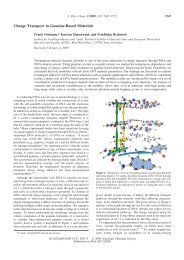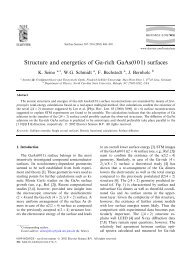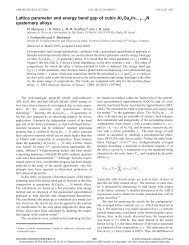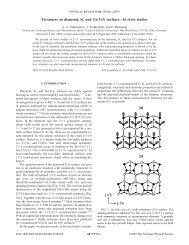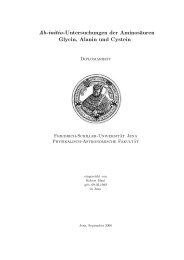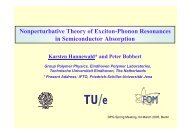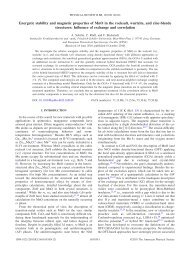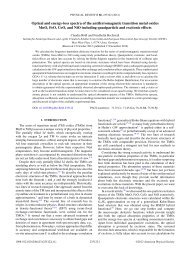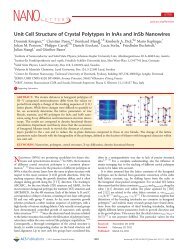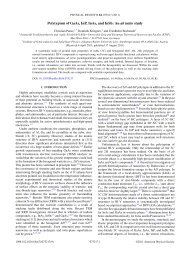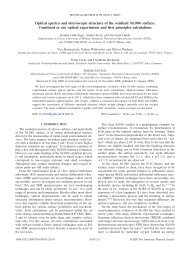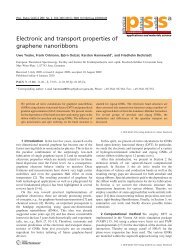Beyond the GW approximation - APS Link Manager - American ...
Beyond the GW approximation - APS Link Manager - American ...
Beyond the GW approximation - APS Link Manager - American ...
Create successful ePaper yourself
Turn your PDF publications into a flip-book with our unique Google optimized e-Paper software.
BEYOND THE <strong>GW</strong> APPROXIMATION: COMBINING ... PHYSICAL REVIEW B 85, 155131 (2012)<br />
contrary to <strong>the</strong> usual electron-hole response function. This<br />
leads to a particle-particle function, L pp<br />
0<br />
(1 − 3) := −iG(1 −<br />
3)G(1 + − 3). We <strong>the</strong>n get, in frequency space,<br />
Ō pp<br />
1 (ω; ω′ ) = v c − v c L pp<br />
0 (ω + ω′ )Ō pp<br />
1 (ω; ω′ ), (A2)<br />
with L pp<br />
0 (ω) =−i ∫ dω ′<br />
2π G(ω′ )G(ω − ω ′ )e iω′η . This, finally,<br />
implies that Ō pp<br />
1<br />
depends only on <strong>the</strong> sum of frequencies as<br />
follows:<br />
Ō pp<br />
1 (ω + ω′ ) = v c − v c L pp<br />
0 (ω + ω′ )Ō pp<br />
1 (ω + ω′ ). (A3)<br />
This is a Dyson-like equation similar to <strong>the</strong> screening equation<br />
in <strong>the</strong> <strong>GW</strong> <strong>approximation</strong>. The time structure of <strong>the</strong> self-energy<br />
becomes<br />
1 (1 − 1 ′ ) = G(4 − 2 + )O pp<br />
1 (12; 1′ 4)<br />
=−iG(4 − 1 + )Ō pp<br />
1 (1 − 1′ ;1− 4) (A4)<br />
and, hence,<br />
∫<br />
pp<br />
dω<br />
′<br />
1 (ω) =−i 2π G(ω′ )Ō pp<br />
1 (ω; ω′ )e iω′ η<br />
∫ dω<br />
′<br />
=−i<br />
2π G(ω′ )Ō pp<br />
1 (ω + ω′ )e iω′η . (A5)<br />
Again, this is very close to <strong>the</strong> structure of <strong>GW</strong>; simply, one<br />
has a “particle-particle-screened” interaction, −Ō pp<br />
1<br />
. One can<br />
verify that <strong>the</strong> time structure of O pp<br />
2<br />
is <strong>the</strong> same as that for<br />
O pp<br />
1 . 2. Electron-hole T matrix<br />
In <strong>the</strong> case of <strong>the</strong> electron-hole T matrix of Eqs. (15) and<br />
(16) one can do similar steps as above and arrive at<br />
Ō1 eh (1 − 5; 1 − 1′ ) = v c δ(11 ′ )δ(1 + 5) − v c L eh<br />
0 (1 − 3)<br />
× Ō1 eh (3 − 5; 3 − 1′ ), (A6)<br />
where we define <strong>the</strong> electron-hole function as L eh<br />
0<br />
(1 − 3) :=<br />
−iG(1 − 3)G(3 − 1 + ). In Fourier space one gets<br />
Ō1 eh (ω + ω′ ) = v c − v c L eh<br />
0 (ω + ω′ )Ō1 eh (ω + ω′ ), (A7)<br />
with L eh<br />
0 (ω) =−i ∫ dω ′<br />
2π G(ω′ )G(ω ′ − ω)e iω′η .<br />
The time structure of <strong>the</strong> self-energy becomes<br />
1 (1 − 1 ′ ) = G(2 − 5 + )O1 eh (15; 1′ 2)<br />
=−iG(1 − 5 + )Ō1 eh (1 − 5; 1 − 1′ ), (A8)<br />
hence,<br />
∫ dω<br />
1 eh<br />
′<br />
(ω) =−i 2π G(ω′ )Ō1 eh (ω′ ; ω)e iω′ η<br />
∫ dω<br />
′<br />
=−i<br />
2π G(ω′ )Ō1 eh (ω − ω′ )e iω′η . (A9)<br />
For O2 eh one can proceed in a similar way as above.<br />
APPENDIX B: SPIN STRUCTURE OF THE T MATRIX<br />
We now schematize <strong>the</strong> spin structure of <strong>the</strong> T matrix. For<br />
both <strong>the</strong> pp and eh T matrix one has, in <strong>the</strong> collinear limit,<br />
(σ ) = G(σ 2 )O(σσ 2 ; σσ 2 ), with<br />
O 1 (σσ 2 ; σσ 2 ) =−iv c + iv c G(σ )O 1 (σσ 2 ; σσ 2 )G(σ 2 ) (B1)<br />
and<br />
O 2 (σσ 2 ; σσ 2 ) = iv c δ σσ2 + iv c G(σ )O 2 (σσ 2 ; σσ 2 )G(σ 2 ).<br />
(B2)<br />
Note that, unlike <strong>the</strong> screened interaction W used in <strong>the</strong> <strong>GW</strong><br />
<strong>approximation</strong>, <strong>the</strong> T matrix is spin dependent.<br />
APPENDIX C: HUBBARD MOLECULE AT 1/2 FILLING<br />
The starting point is <strong>the</strong> following Hubbard Hamiltonian:<br />
H =−t<br />
∑<br />
i,j=1,2<br />
i≠j<br />
+ ɛ 0<br />
∑<br />
σ,i=1,2<br />
∑<br />
c † iσ c jσ + U ∑ ∑<br />
c † iσ<br />
2<br />
c† iσ ′c iσ ′c iσ<br />
σ<br />
σσ ′<br />
n iσ + V 0 .<br />
i=1,2<br />
(C1)<br />
Here n iσ = c † iσ c iσ, where c † iσ and c iσ are <strong>the</strong> creation and<br />
annihilation operators for an electron at site i with spin σ , U is<br />
<strong>the</strong> on-site (spin-independent) interaction, −t is <strong>the</strong> hopping<br />
kinetic energy, and ɛ 0 is <strong>the</strong> orbital energy. The Hamiltonian<br />
fur<strong>the</strong>r contains a potential V 0 that can be chosen to fix <strong>the</strong><br />
zero-energy scale. The eigenstates of <strong>the</strong> system will be linear<br />
combinations of Slater determinants, which are denoted by<br />
<strong>the</strong> kets |1 2〉, with occupations of <strong>the</strong> sites 1, 2 given by<br />
0, ↑, ↓, ↑↓. We choose ɛ 0 =− U 2 and V 0 = U N, where N<br />
2<br />
is <strong>the</strong> total number of electrons in <strong>the</strong> system, i.e., 2 in our<br />
case. This choice is particularly convenient since <strong>the</strong> obtained<br />
Hamiltonian,<br />
H =−t<br />
− U 2<br />
∑<br />
i,j=1,2<br />
i≠j<br />
∑<br />
σ,i=1,2<br />
∑<br />
c † iσ c jσ + U ∑ ∑<br />
c † iσ<br />
2<br />
c† iσ ′c iσ ′c iσ<br />
σ<br />
σσ ′<br />
n iσ + U,<br />
i=1,2<br />
(C2)<br />
has high symmetry (particle-hole symmetry), as we shall see<br />
below (see also Ref. 70). Using this Hamiltonian we can<br />
calculate <strong>the</strong> exact one-particle Green’s function.<br />
1. Exact solution<br />
The main exact quantities we are interested in are<br />
[ ( )<br />
G σ (−1)(i−j) 1 +<br />
4t 2<br />
(c−U)<br />
ij (ω) =<br />
2a 2 ω − (c/2 − t) + iη<br />
+ (−1)(i−j)( )<br />
1 − 4t 2 ]<br />
(c−U)<br />
ω − (c/2 + t) + iη<br />
+ 1 [ ( )<br />
1 +<br />
4t 2<br />
(c−U)<br />
2a 2 ω + (c/2 − t) − iη<br />
+ (−1)(i−j)( )<br />
1 − 4t 2 ]<br />
(c−U)<br />
, (C3)<br />
ω + (c/2 + t) − iη<br />
[<br />
]<br />
G 0,σ<br />
ij<br />
(ω) = (−1)(i−j) 1<br />
2 ω − t + iη + (−1)(i−j)<br />
, (C4)<br />
ω + t − iη<br />
155131-13



